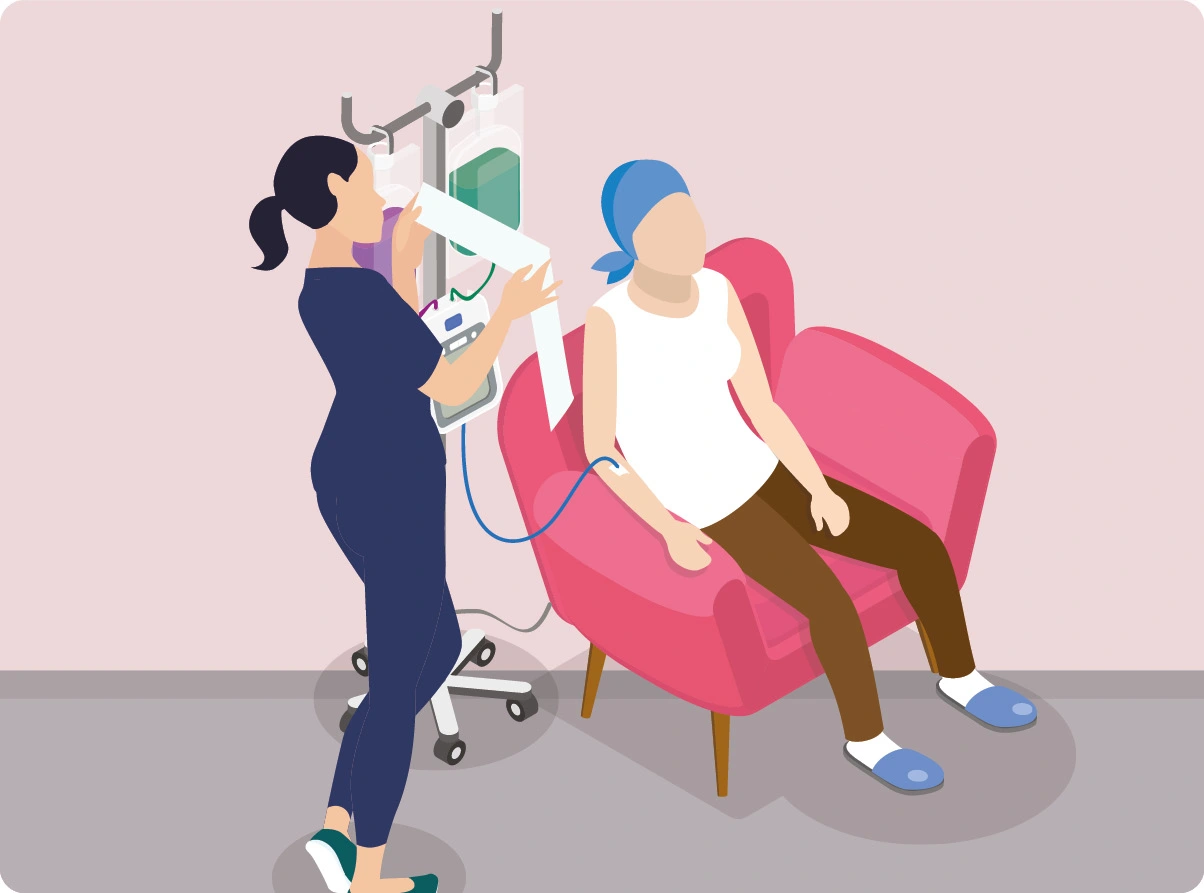News & Articles

What to Expect at Your First Session of Chemotherapy

Understanding the treatment and its possible side effects can help you prepare.
THE THOUGHT OF STARTING CHEMOTHERAPY CAN FEEL DAUNTING, ESPECIALLY FOR FIRST-TIME PATIENTS.
Knowing what intravenous (IV) chemotherapy is, how it works and what to expect can make the process more manageable.
IV chemotherapy delivers cancer-fighting drugs directly into the bloodstream through a vein, targeting cancer cells throughout the body. However, because it also affects healthy cells that divide rapidly, side effects can occur.
Doctors tailor chemotherapy regimens to each patient, using specific drug combinations and dosing schedules to maximise effectiveness while minimising side effects. Chemotherapy is one of the most effective cancer treatments. Close monitoring and proactive side-effect management can smoothen the process.
PREPARING FOR YOUR SESSION
Being well-prepared can help reduce anxiety and make treatment days more manageable. Speaking with your doctor beforehand is key to understanding the process and preparing for any side effects. Planning for logistics and daily responsibilities can also be useful to avoid overtaxing yourself during treatment.
Arranging transportation to and from sessions can help, as you may feel fatigued afterwards. Clearing your schedule for rest aids recovery. If you need help at home, seek support from family or friends. If you are working, consider speaking to your employer about adjusting your schedule. Having nutritious, easy-to-prepare foods on hand will help you maintain a balanced diet throughout treatment. On treatment day, wear comfortable clothing and eat a light meal before your session.
WHAT TO BRING
Chemotherapy sessions can last from minutes to several hours, depending on the treatment. Bringing a few essentials can help you stay comfortable. A light jacket can keep you warm, as treatment centres can be a little cold due to air-conditioning. A small neck pillow or blanket may also make long sessions more comfortable.
Staying hydrated is important, so bring water or other non-caffeinated drinks too, along with some healthy snacks. If you want to pass the time, consider bringing earphones or headphones, a book or magazine, or even a journal or sketchbook if you enjoy writing or drawing.
WHAT HAPPENS DURING A SESSION
Each patient’s chemotherapy experience varies, but most sessions follow a similar routine. Upon arrival, you will check in, and your vital signs — blood pressure, pulse and temperature — will be recorded. If you do not have a catheter or port, an IV line will be inserted. Before treatment, your name, medication and dosage will be double-checked for accuracy.
Chemotherapy drugs will then be delivered through the IV, port or catheter. Infusion times vary, with some sessions lasting minutes and others taking hours. Once the treatment is complete, your vital signs will be checked again before you leave.
MANAGING COMMON SIDE EFFECTS
Side effects can vary from person to person. Some experience just mild symptoms, while others have more pronounced effects. One of the most common side effects is fatigue, which can be managed by adjusting daily routines, prioritising rest, reducing workload and seeking support at home. Light physical activity, if approved by your doctor, may help.
Hair loss is another possible side effect. Some patients choose to cut their hair shorter before treatment to ease the transition. If you experience hair loss, options such as wigs, scarves or head wraps can help with confidence and comfort. Scalp cooling, which may reduce hair loss for some patients, is another option to discuss with your doctor.
Nausea and vomiting may occur, but staying hydrated and sipping fluids regularly can help. Anti-nausea medication can also be prescribed if needed. Some patients notice changes in their appetite, which may be easier to manage by eating small, frequent meals throughout the day. A dietitian can provide guidance on meal planning and nutritional support.
Mouth dryness and sores can also develop. Drinking water frequently, maintaining good oral hygiene and using moisturising mouthwashes may help. Pain is another possibility, but it can often be controlled with medication — speak to your doctor if it worsens.
For patients who have not yet completed family planning, chemotherapy can affect fertility. If this is a concern, discuss fertility-preserving options with your doctor before starting treatment.
Each chemotherapy treatment may have unique side effects, which your doctor will discuss with you beforehand. Patients may also react differently to chemotherapy. If you experience unusual symptoms, inform your healthcare team, as most side effects can be managed with lifestyle modifications or medications.
RECOVERY AFTER TREATMENT
Recovery involves rest, hydration and a balanced diet. Pay attention to your body’s signals, as fatigue and other side effects may persist. Tracking lingering symptoms and communicating with your care team can help address your concerns. Follow-up tests will also determine if adjustments to your treatment are needed.
Most importantly, stay hopeful and positive. While chemotherapy can be challenging, being prepared, having support and adjusting your daily routine can help you manage treatment with greater confidence. Most side effects are also temporary, and you can look forward to regaining your health after completing the planned course of treatment.
| POSTED IN | Cancer Treatments |
| TAGS | cancer drugs, cancer hair loss, chemotherapy, common side effects of cancer treatment |
| PUBLISHED | 01 April 2025 |
